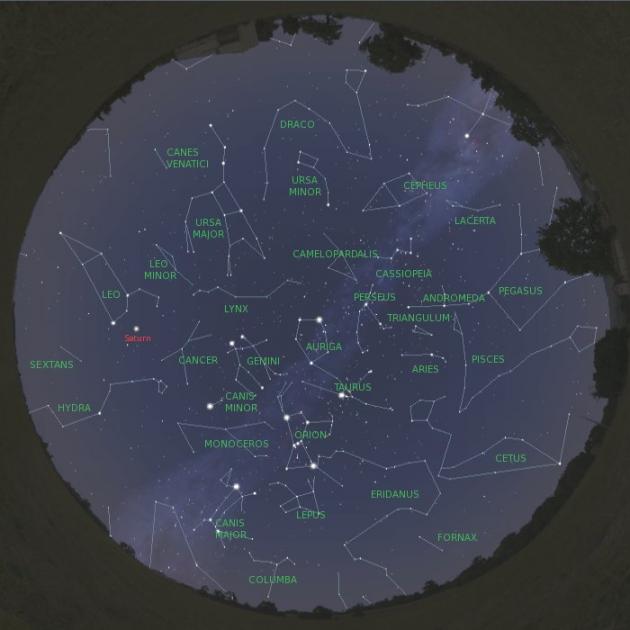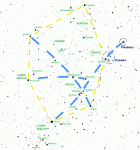- News / Thoughts
- Astronomy Guide
- On This Day
- Reviews
- Bookstore
Astronomical Events for January 2007
12/30/2006Even colder weather tells us that we've stepped well into winter season. Although each of us tries to warm ourselves up in our homes, and rarely does anyone like the idea of spending few hours in the cold, nature used her artistic hand on the celestial sphere, and gave us the brightest constellations.
This month we can rehearse, or learn, orientation on the winter sky using winter hexagon, spot two bright planets, and look at one of the nicest open cluster.
O

Evening sky for the middle of January 2007. at 9PM. The map is valid for northern hemisphere, especially positions near 45 degrees latitude.
Many people consider that the night sky is, somewhat ironically, most beautiful in the winter, when it's hardest to get us under sky dome. One of the remarks of winter sky is winter hexagon, which passes through six constellations: Orion, Canis Major, Canis Minor, Gemini, Auriga and Taurus.
Constellation dominating winter sky is definitively Orion, and we've touched some interesting bits in that constellation last month. If you still don't know how to find Orion, here is a little trick: on the January 3, as the Sun sets in, look for the full Moon. It'll be in the Gemini constellation. On the left of the Moon, you'll spot two stars, Castor and Pollux, which designate the heads of two twins. Start gazing toward south, rightward of the Moon, and you'll soon notice three stars in a row which make Orion's belt. Once you find Orion, and get used to it's size on the sky, you'll easily recognize it anytime.
Given that the Orion is such a remarkable constellation, thanks to its star pattern, it is also useful as celestial sign post. It allows us to discover other, Orion's neighboring, constellations. You'll probably need to wait a bit, but when Orion raises enough, you'll be able to see winter hexagon just fine.
o
O

Winter hexagon, and guides how to find nearby stars and celestial objects using Orion constellation.
I'll try to guide you how to find Orion's neighboring constellations. As an aid, use the image on your left side (open larger image in a new window, and resize as needed).
After you spot Orion's belt made of stars Alnitak, Alnilam and Mintaka, imagine that a line is passing through them. If you follow that line downwards, you'll reach the brightest star on the celestial sphere, the Sirius. Sirius is positioned in the constellation Canis Major, which is the southernmost constellation of winter hexagon.
If you follow Orion's belt line in the opposite direction, you'll find bright red star Aldebaran, which is located in the constellation of Taurus, and itself designates one eye of the Bull. Then if you use binoculars to magnify that area, you'll spot myriad of stars, making open cluster called Hyades. Continue a bit more in the direction Orion's belt - Hyades, and you'll find another open cluster called Pleiades. Pleiades are arguably most popular open cluster among amateur astronomers. You can also use your binoculars here to decipher Pleiades star pattern.
To find next constellation, Canis Minor, use the topmost stars of Orion, which are usually considered his shoulders. Starting from Bellatrix through Betelgeuse you'll reach a star called Procyon. Canis Minor is the smallest constellation in the winter hexagon.
As long as we're using Orion's stars, take a note on how different star colors can be. Rigel, bottom right star, has bluish tint, but the Betelgeuse, upper left star, has distinctively reddish color. The colors will be much more noticeable if you use binoculars.
Let us now use those contrasting stars. Make a line from Rigel through Betelgeuse and soon you'll find two bright stars, Castor and Pollux in the Gemini constellation. Castor and Pollux designate heads of the twins, holding each other's hand.
Up till now, we've found five of six constellation making winter hexagon, and our guides were star patterns on the celestial sphere. As the night progresses, all constellations will rotate a bit, but the star guides will still work. That method is called star-hopping. We hop from one bright star to the other, until we reach wanted celestial object. You can find "new guides" yourself, just pick bright star patterns you find useful. For example you can find sixth constellation, Auriga, using the line passing through Orion's Rigel and Bellatrix, or, just for the fun of it, find some other guide.
Now, after a bit of practice, you've found, or learned, six constellations. The brightest stars in them are Sirius, Rigel, Aldebaran, Capella, Pollux and Procyon. If you connect them all, you'll get winter hexagon.
It would be prudent if you'd get out on the first clear night and find those constellations on the sky dome. Of course, you'll be able to find them throughout the winter. While you're at it, don't forget to use your binoculars, and take a peek at the Hyades and Pleiades open clusters.
Also this month you'll be able to spot two planets. You can find planet Venus during sunsets. It'll be the brightest "star" close to Sun while it sinks below horizon, which is the reason why its sometimes called the evening star. Be sure not to use binoculars if there is even slightest chance that the Sun will be in your field of view. That is the fastest way to blind yourself forever. I must repeat this... Don't ever look directly at the Sun, especially using binoculars or telescope. That would be your last look forever! If you want to spot Venus, wait until Sun sets below horizon, Venus will still be above it.
The other planet is Saturn, which you may have seen last month. You can find it few hours after sunset on the eastern horizon, again as the brightest red tinted star. Using your binoculars you might be able to recognize Saturn's rings.
Venus and Saturn will be in even better viewing positions in the upcoming months, so don't be afraid, they won't disappear from sky that soon.
Also use your binoculars for looking at the Moon. The best time for Moon gazing is when it's not full, and you'll be able to spot most details at it's terminator, the line separating day and night on the Moon. Here are main phases of the moon for January 2007:
- Full Moon - January 3. 13:57 UT
- Last Quarter - January 11. 12:45 UT
- New Moon - January 19. 04:01 UT
- First Quarter - January 25. 23:02 UT